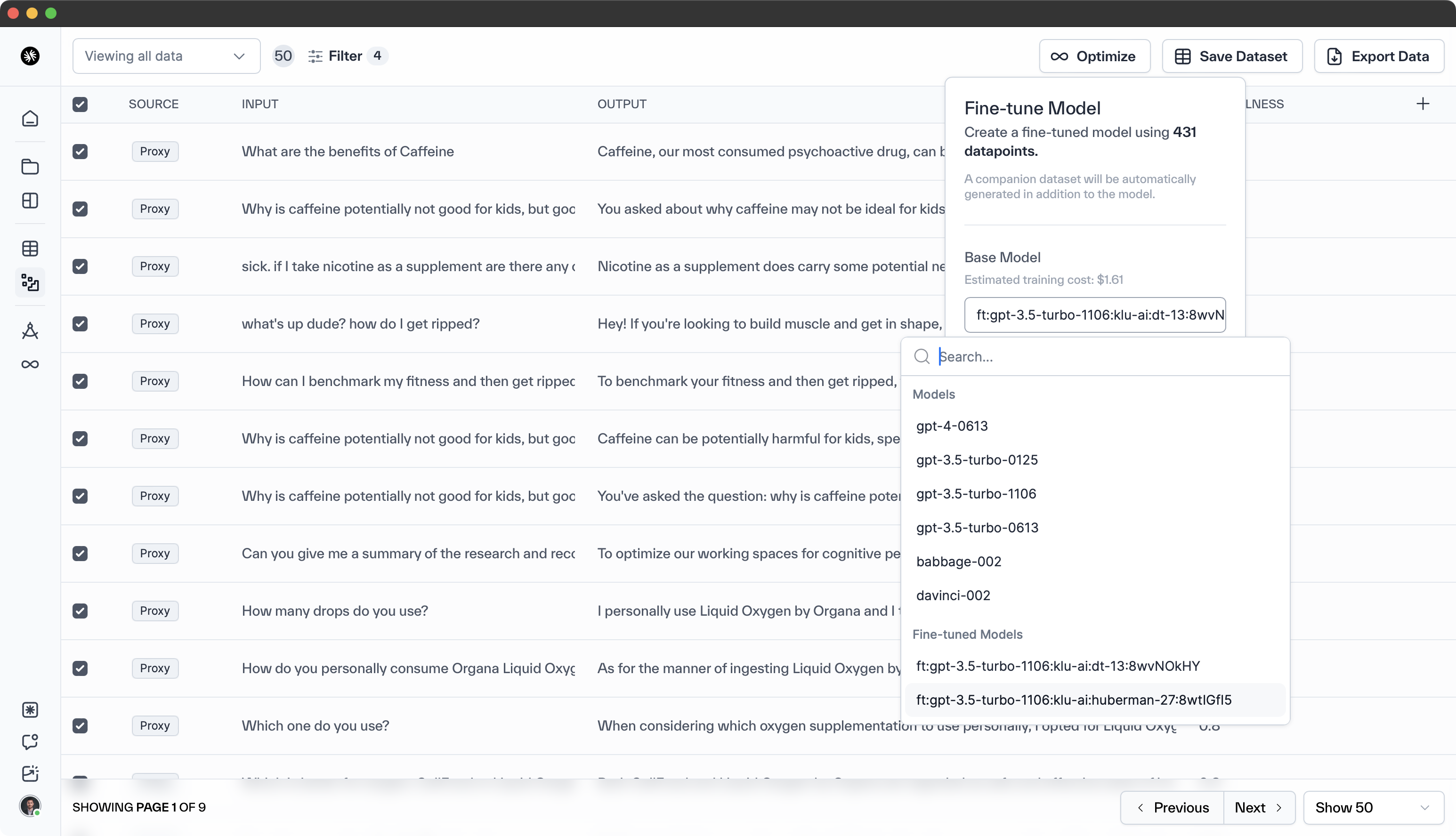Guide: Simplifying GPT-3.5 Turbo Fine-tuning with Klu.ai
by Stephen M. Walker II, (Co-Founder / CEO)
Top tip
Note: This guide focuses on fine-tuning OpenAI GPT-3.5 Turbo using Klu.ai. For guidance on manually preparing data and executing the fine-tuning process, please refer to another guide in the blog archive.
Last week OpenAI released fine-tuning capabilities for the latest GPT-3.5 fine-tuning model with greater improvements for function calling. Klu is the only LLM app platform that makes the fine-tuning process more effecient and effective.
Overview of the fine-tuning process for GPT-3.5-turbo
Embarking on the journey of fine-tuning the GPT-3.5 Turbo model is a meticulous process that ensures your model is tailored to understand and generate responses based on your specific dataset. This process is broken down into detailed steps to guide you through from start to finish:
-
Data Filtering: Begin by sifting through your dataset to identify and remove any inputs that are irrelevant, of low quality, or could potentially introduce bias into your model. This step is crucial for maintaining the integrity and quality of your training data.
-
Dataset Construction: After filtering, the next step is to organize the remaining high-quality data into a structured dataset. This involves categorizing, tagging, and possibly anonymizing data to prepare it for the fine-tuning process. A well-organized dataset is key to effective model training.
-
Model Fine-Tuning: With your dataset prepared, you can now proceed to fine-tune the GPT-3.5 Turbo model. This involves adjusting the model's parameters and training it on your dataset so that it learns the specific patterns, nuances, and information present in your data.
-
Initial Performance Assessment: Once the fine-tuning is complete, it's important to view and analyze the initial results. This step allows you to gauge the model's performance and identify any immediate areas for improvement.
-
Comprehensive Model Evaluation: The final step involves a thorough evaluation of the model against a set of predefined criteria to ensure it meets your desired standards and objectives. This may include testing for accuracy, bias, and the ability to generalize across different types of inputs.
By meticulously following these steps, you can fine-tune the GPT-3.5 Turbo model to better suit your specific needs and ensure it performs optimally for your applications.






1. Format Your Data
Organize your data as a series of interactions between the system, user, and assistant. This typically involves creating a JSON file with a list of dictionaries, where each dictionary represents a conversation with alternating user and assistant messages.
2. Clean and Preprocess Your Data
Ensure that your data is clean and free of errors. This may involve removing duplicates, correcting errors, and normalizing the data to ensure consistency.
3. Upload Your Data
Use a curl command or an API client to send your prepared data to OpenAI's API. You'll need to provide your API key for authentication and finish the API call.
4. Create a Fine-Tuning Job
Send a request to OpenAI's API to initiate the fine-tuning process. This request should include essential parameters like the model you want to fine-tune (e.g., gpt-3.5-turbo), the dataset you've uploaded, and any additional settings.
All the Python code used to create the ChatJRE is provided sequentially as in the Juptyer Notebook used to fine-tune the model. Python is the preferred language used to complete the process.
Before diving into the details, make sure to import the required libraries and bind your OpenAI API key:
import json
import openai
from collections import defaultdict
import numpy as np
openai.api_key = "[YOUR_API_KEY]"
Preparing Data for Fine-Tuning GPT 3.5 Turbo Model
Using the Right Data Format for Fine-Tuning
Cleaning and preprocessing data
Cleaning and preprocessing data for GPT-3.5 Turbo involves several steps, such as:
-
Remove duplicates — Eliminate duplicate data points to prevent bias in the model.
-
Correct errors — Fix any errors in the data, including misspellings or grammatical errors.
-
Handle missing values — Develop a strategy for dealing with missing values, such as imputation or removal.
-
Standardize capitalization — Ensure consistent capitalization throughout the dataset.
-
Convert data types — If necessary, convert data types to a suitable format for GPT-3.5 Turbo.
-
Remove irrelevant data — Eliminate data that is not relevant to the task or context.
-
Deal with outliers — Identify and manage outliers in the data, either by removal or transformation.
-
Normalize or scale data — If applicable, normalize or scale the data to ensure consistent ranges.
For more detailed cleaning and preprocessing instructions, refer to OpenAI's documentation and guidelines for handling data effectively.
Best practices for data preparation
Fine-Tuning the GPT 3.5 Turbo Model
Uploading and Initiating Fine-Tuning
Using and Evaluating Fine-Tuning Results
How Klu.ai Simplifies the Fine-Tuning Process
Conclusion
Frequently Asked Questions
Cost Considerations
The more the sample you use, the more token is needed. The cost of fine-tuning the GPT-3.5 Turbo model is $0.008 per thousand tokens, which is about four to five times the cost of inference with GPT-3.5 Turbo 4k. The cost of a fine-tuning job with a training file of 100,000 tokens that is trained for three epochs would have an expected cost of $2.40. The cost of fine-tuning GPT-3.5 Turbo 16k is twice as much as the base model but offers more room for prompt engineering and context.
You can approximate how much using the OpenAI's cookbook instruction on tokens to make sure you are building a cost-effective model.
How much dataset is needed?
OpenAI recommends using 50-100 samples. It is important to collect a diverse set of examples that are representative of the target domain and use high-quality data for effective fine-tuning.
Ways to access or deploy your Fine-Tune Model
Once the fine-tuning process is complete, you can use the fine-tuned model via OpenAI's chat completions endpoint. It is important to note that your fine-tuned models are specific to your use case and cannot be accessed by other users. Also, you can use or deploy your fine-tuned model using LangChain or Klu.ai.